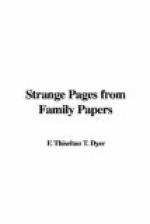But there is no mystery about the so-called “Bloody Chamber,” for the marks are only in reality natural red tinges of the wood, denoting the presence of iron.
In addition to the appearance of such indelible marks of crime, oftentimes the ghost of the spiller of blood, or of the murdered person, haunts the scene. Thus, Northam Tower, Yorkshire, an embattled structure of the time of Henry VII.—a true Border mansion—has long been famous for the visits of some mysterious spectre in the form of a lady who was cruelly murdered in the wood, her blood being pointed out on the stairs of the old tower. Another tragic story is told of the Manor House which Bishop Pudsey built at Darlington. It was for very many years a residence of the Bishops of Durham, and a resting place of Margaret, bride of James iv., of Scotland, and daughter of Henry VII., in her splendid progress through the country. This building was restored at great expense in the year 1668, and gained a widespread notoriety on account of the ghost story of Lady Jerratt, who was murdered there; but, as a testimony of the violent death she had received, “she left on the wall ghastly impressions of a thumb and fingers in blood for ever,” and always made her appearance with one arm, the other having been cut off for the sake of a valuable ring on one of the fingers.
One room of Holland House is supposed to be haunted by Lord Holland, the first of his name and the chief builder of this splendid old mansion. According to Princess Marie Lichtenstein, in her “History of Holland House,” “the gilt room is said to be tenanted by the solitary ghost of its first lord, who, runs the tradition, issues forth at midnight from behind a secret door, and walks slowly through the scenes of former triumphs with his head in his hand.” And to add to this mystery, there is a tale of three spots of blood on one side of the recess whence he issues—three spots which can never be effaced.
Stains of blood—stains that cannot be washed away—are to be seen on the floor of a certain room at Calverley Hall, Yorkshire. And there is one particular flag in the cellar which is never without a mysterious damp place upon it, all the other flags being dry. Of course these are the witnesses of a terrible tragedy which was committed years ago within the walls of Calverley Hall. It appears that Walter Calverley, who had married Philippa Brooke, daughter of Lord Cobham, was a wild reckless man, though his wife was a most estimable and virtuous lady, and that one day he went into a fit of insane jealousy, or pretended to do so, over the then Vavasour of Weston. Money lenders, too, were pressing him hard, and he had become desperate. Rushing madly into the house, he plunged a dagger into one and then into another of his children, and afterwards tried to take the life of their mother, a steel corset which she wore luckily saving her life. Leaving her for dead, he mounted his horse with the intention of killing




